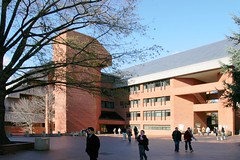One of my deep pleasures is to interact with a large set of research-active faculty, each of whom is pushing the edges of developments in their fields. Of course, the scholarship and research tools that they use are highly variable across fields. The culture of research also varies – some work in teams, some work by themselves. The gestation periods for research projects also vary, from months to years. In watching and talking to such scholars there seem to be, however, some common elements of their day-to-day lives.
Time management – many have very well-defined schedules of their weeks, with designated periods for different types of research-related work. Reading and idea generation can be scattered throughout the day in bits (letting the brain do its synthesis magic over time), but writing seems to be best done in large blocks. A common daily regimen seems to be waking up early (before the rest of the household) and in the quiet of the morning, carving out a few hours of solitary writing.
Collecting and documenting new ideas — many of the most productive have integrated their teaching and research. Some even claim that their best research ideas have come from trying to answer a question from a student. The most generative questions appear to be those not based on the traditional conceptual framework of the field. The reaction cited is often “I never thought of it that way before.” Followed by, “Why haven’t I thought of it that way before?” The best among us have some way to document these ideas, creating idea lists for the next projects they might mount.
Working on multiple tasks concurrently – A common feature appears to be that the person is always working on multiple research projects. They are often in different stages of maturation. When the researcher finds they are running out of energy on one project, they switch to another, then return to the first with new perspectives. It seems to be a useful tool to avoid completely blocked progress.
Pushing an idea in successive stages – Many of the faculty have invented ways to try out big research ideas in little pieces. They may use an essay to sketch the ideas of a book; they may publish the seeds of an idea in a lower ranked journal just to articulate a disciplined presentation of the idea. If reactions to the small step are positive, the next step may be a bigger chunk of the work.
Knowing when an idea isn’t ready – The best researchers come up with more ideas than they can ever pursue. Success comes both from devoting time on the ideas with greatest promise and avoiding spending time on ideas that, upon reflection, don’t have merit. The best among us seem to have ways of rejecting unworkable ideas very quickly. Some seek out interaction with colleagues, seeking active critique.
Importing approaches from other fields – It was interesting to learn that how many of our most productive colleagues are reading the research literatures outside their fields. They seek the importation of concepts or methods used in other domains to their own. Often that innovation permits new perspectives on old problems and new insights unlocked with methods formerly not used in the field.
Using other minds – Importing new ideas from other fields is quite compatible with collaborations across boundaries. The boldest of our colleagues seek out experts in other fields as partners in new research, often producing breakthroughs in creativity.
Nurturing critical readers of one’s work – Very, very few among us can produce perfect writing in one iteration. One of the surprises to students is the number of drafts that most research products require on their way to completion. So, the most precious resource a scholar can have is a colleague willing to critically (but constructively) evaluate early drafts. For such relationship to be sustainable, however, most often there is a reciprocation. You read my work; I read your work. Even better, when the two scholars are collaboratively producing the research product, there is an organic other-person evaluation. That is, in fact, one of the pleasures of collaborative work.
Persevering with good ideas even in the face of failure – Many of our colleagues have stories about failures in early attempts at some project (e.g., failure to convince anyone of its merits and losing support; inability to implement the methods proposed). Some of the stories cite coming back to a failed idea years later and succeeding in the project. The scholar’s life often experiences more failures than successes. It is the unrivaled sweetness of the successes that make us forget the failures. Thus, resilience and tolerance of deferred gratification are personal traits of the best scholars.

It’s a sad commentary on how Georgetown works that faculty have to wake up early to have enough time to think and write. Perhaps that’s not a sign of how things should operate but rather a sign that this university has a crushing service load.